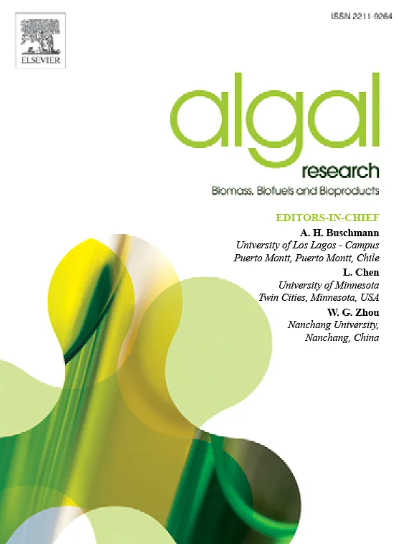Application of microalgae in remediation of heavy metal-contaminated soils and its stimulatory effect on wheat growth
IF 4.6
2区 生物学
Q1 BIOTECHNOLOGY & APPLIED MICROBIOLOGY
Algal Research-Biomass Biofuels and Bioproducts
Pub Date : 2025-03-09
DOI:10.1016/j.algal.2025.103995
引用次数: 0
Abstract
Heavy metal pollution has emerged as a significant threat to global soil environments, adversely impacting crop safety and human health. This study investigates the potential of microalgae as an environmental bioremediation tool and plant growth regulator. By examining the effects of four living microalgae species—Anabaena azotica, Anabaena variabilis, Chlorella vulgaris, and Scenedesmus obliquus—on cadmium (Cd) levels in soil and wheat, we assessed their ability to enhance soil fertility and promote wheat growth under varying cell number treatments. Our findings revealed that all four microalgae effectively reduced soil exchangeable Cd and limited Cd accumulation in wheat roots and stems. Remarkably, significant remediation effects were observed even at low-dose treatments, indicating that effective bioremediation does not solely rely on high concentrations. Additionally, the treatments notably increased soil organic matter, alkali-hydrolyzable nitrogen, available phosphorus, and available potassium. The pot experiments demonstrated that microalgae treatments significantly enhanced wheat root lengths, seedling growth, biomass, chlorophyll content, as well as soluble sugars and proteins. Importantly, low-dose treatment with A. azotica surpassed high-dose effects on wheat growth, highlighting the cost-effectiveness and practicality of low-dose applications. This study offers a scientific foundation for further exploring the role of microalgae in remediating heavy metal pollution and promoting crop development.
求助全文
约1分钟内获得全文
求助全文
来源期刊

Algal Research-Biomass Biofuels and Bioproducts
BIOTECHNOLOGY & APPLIED MICROBIOLOGY-
CiteScore
9.40
自引率
7.80%
发文量
332
期刊介绍:
Algal Research is an international phycology journal covering all areas of emerging technologies in algae biology, biomass production, cultivation, harvesting, extraction, bioproducts, biorefinery, engineering, and econometrics. Algae is defined to include cyanobacteria, microalgae, and protists and symbionts of interest in biotechnology. The journal publishes original research and reviews for the following scope: algal biology, including but not exclusive to: phylogeny, biodiversity, molecular traits, metabolic regulation, and genetic engineering, algal cultivation, e.g. phototrophic systems, heterotrophic systems, and mixotrophic systems, algal harvesting and extraction systems, biotechnology to convert algal biomass and components into biofuels and bioproducts, e.g., nutraceuticals, pharmaceuticals, animal feed, plastics, etc. algal products and their economic assessment
 求助内容:
求助内容: 应助结果提醒方式:
应助结果提醒方式:


